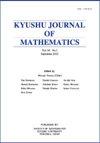有限乘积的子商及其自同伦等价
IF 0.5
4区 数学
Q3 MATHEMATICS
引用次数: 0
摘要
给定集合X = (X1, X2,…), Xm)时,引入X1 × X2 ×···× Xm的子商{X(k,l)}族。这个族扩展了G. J. Porter引入的X1 × X2 ×··× Xm的子空间族,包含积、胖楔、楔和碎积。完全确定了X(k,l)与场系数的(co)同调,用它来研究X(k,l)的自同伦等价的群E(X(k,l))。特别是在X1 = X2 =···= Xm = X的情况下,构造了m-叠积E(X)m与对称群Sm到E(X(k,l))的半直积的同态(k,l),并给出了(k,l)是内射的充分条件。我们将这一结果应用于X = Sn, CPn,或K (Ar, n),其中A是Q的子群或域Z/p,给出了E(X(K,l))的重要子群。本文章由计算机程序翻译,如有差异,请以英文原文为准。
SUBQUOTIENTS OF A FINITE PRODUCT AND THEIR SELF-HOMOTOPY EQUIVALENCES
Given a set X = (X1, X2, . . . , Xm) of pointed spaces, we introduce a family {X(k,l)} of subquotients of X1 × X2 × · · · × Xm . This family extends the family of subspaces of X1 × X2 × · · · × Xm introduced by G. J. Porter and contains the product, the fat wedge, the wedge and the smash product. The (co)homology with field coefficients of X(k,l) is completely determined, which is used to study the group E(X(k,l)) of self-homotopy equivalences of X(k,l). Especially, in the case of X1 = X2 = · · · = Xm = X , we construct a homomorphism (k,l) from the semi-direct product of the m-fold product E(X)m and the symmetric group Sm to E(X(k,l)) and give sufficient conditions for (k,l) to be injective. We apply this result to the case where X = Sn , CPn , or K (Ar , n) with A a subring of Q or a field Z/p, providing an important subgroup of E(X(k,l)).
求助全文
通过发布文献求助,成功后即可免费获取论文全文。
去求助
来源期刊
CiteScore
0.80
自引率
0.00%
发文量
10
审稿时长
>12 weeks
期刊介绍:
The Kyushu Journal of Mathematics is an academic journal in mathematics, published by the Faculty of Mathematics at Kyushu University since 1941. It publishes selected research papers in pure and applied mathematics. One volume, published each year, consists of two issues, approximately 20 articles and 400 pages in total.
More than 500 copies of the journal are distributed through exchange contracts between mathematical journals, and available at many universities, institutes and libraries around the world. The on-line version of the journal is published at "Jstage" (an aggregator for e-journals), where all the articles published by the journal since 1995 are accessible freely through the Internet.

 求助内容:
求助内容: 应助结果提醒方式:
应助结果提醒方式:


